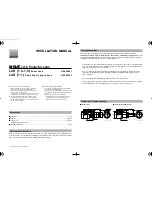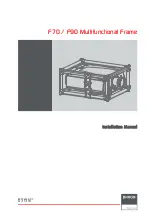
Asynchronous Transfer Mode (ATM) Module Installation and User Guide
3-37
Configuring QoS Functions
Configuring RED Drop Probability
To configure the RED drop probability for a specified ATM port, use the following
command:
config red [drop-probability | low-drop-probability | high-drop-probability]
<percent> {ports <portlist>}
The optional
low-drop-probability
,
high-drop-probability
, and
ports
keywords
are supported only for ATM ports.
If you omit the
ports
keyword, the command applies the setting to all ports.
The drop probability is specified as a percentage, where the
percent
parameter is an
integer in the range from 1 to 100.
Weighted RED (WRED) functionality is supported through two different drop
probabilities: a low-drop-probability and a high-drop-probability. The DiffServ code
points of IP packets indicate whether the packet should be dropped with low
probability or high probability, and the appropriate percentage is then applied if WRED
is active.
WRED is applied only to IP packets. The
config diffserv examination
code-point
command gives you complete flexibility in assigning DSCPs to the
two different drop-probability levels. This configured mapping of DSCPs to
drop-probability levels is used by WRED even if
diffserv examination
is
disabled on the port.
The
drop-probability
keyword indicates that the specified percentage should be used
for both the low and high drop-probabilities. This effectively disables WRED and
reverts to standard RED operation. For ATM ports, both the low and high
drop-probabilities default to 10%.
The role of the configured drop probability in RED operation on ATM ports is
illustrated in Figure 3-3A. RED is active when the average queue length is between the
minimum and maximum thresholds. In this region, the probability that a given packet
is dropped increases in a straight line up to the configured drop probability at the
maximum threshold. All packets are dropped when the average queue length exceeds
the maximum threshold.
The operation of WRED on ATM ports is depicted in Figure 3-3B. In this case, the drop
probability depends not only on the average queue length, but also upon whether the
Summary of Contents for BlackDiamond 6800
Page 8: ...viii Asynchronous Transfer Mode ATM Module Installation and User Guide ...
Page 10: ...x Asynchronous Transfer Mode ATM Module Installation and User Guide ...
Page 14: ...xiv Asynchronous Transfer Mode ATM Module Installation and User Guide ...
Page 100: ...A 8 Asynchronous Transfer Mode ATM Module Installation and User Guide ...
Page 104: ...B 4 Asynchronous Transfer Mode ATM Module Installation and User Guide ...
















































